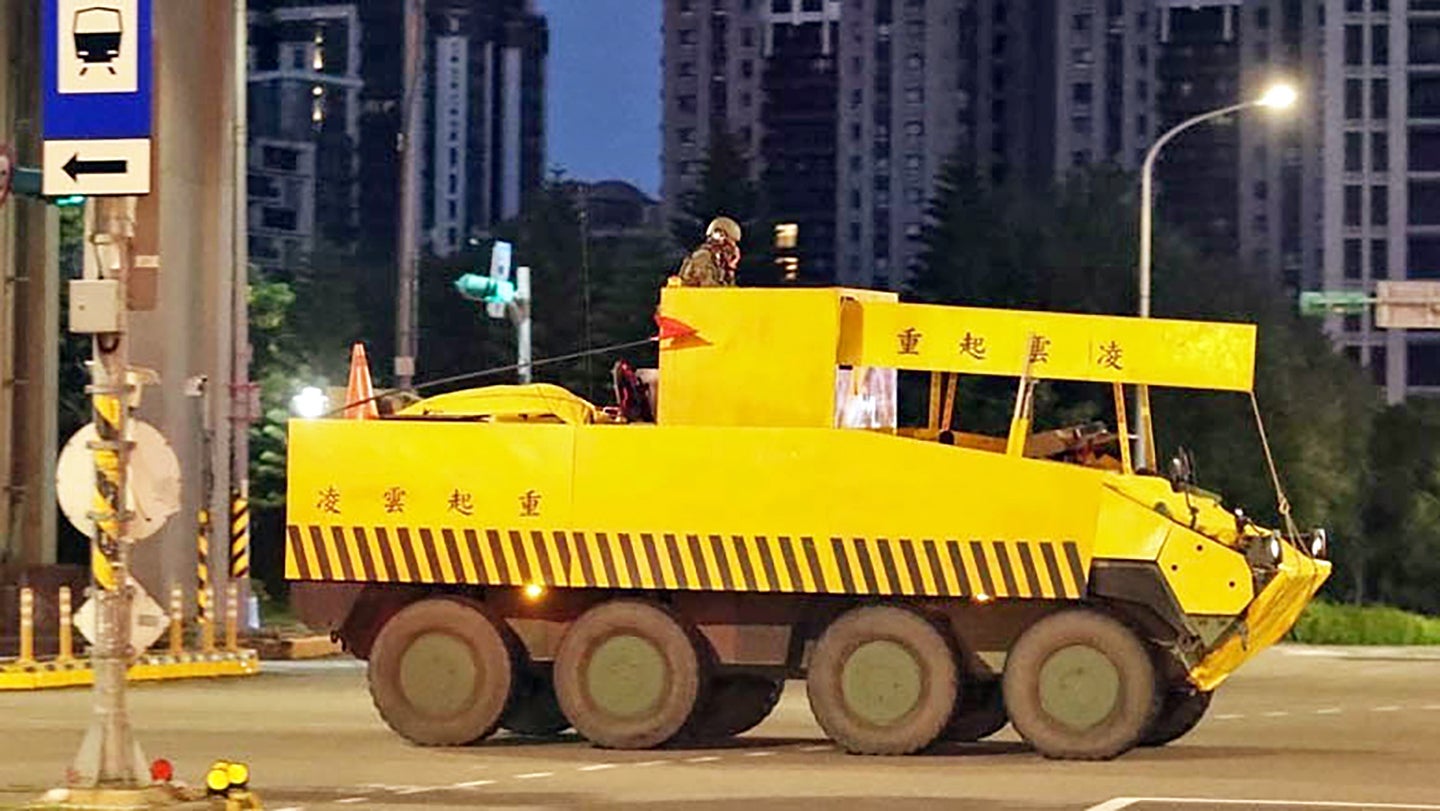The lengths that Taiwan’s Republic of China Army goes to ensure its armored vehicles might survive a potential invasion from the Chinese mainland were made abundantly clear during the country’s latest series of war games. The recent Combat Readiness Week brought images of tanks and other armored vehicles hidden in urban environments using some ingenious camouflage methods, including hiding them under junk and making them look like civilian construction equipment.
While it’s commonplace for military vehicles operating in rural terrain to be liberally adorned with foliage, the same technique can have a place in the cityscape too. A photo released by the Republic of China (ROC) Military News Agency showed several M113 armored personnel carrier variants sheltered under a highway bridge and covered in the types of ferns and ivy that might grow through the cracks in these urban environments.

More extreme measures to blend into the backdrop of the city included what appeared to be a Clouded Leopard 8×8 infantry fighting vehicle adapted to look like a yellow civilian crane. The effect was achieved using a combination of yellow-painted wooden boards and fabric.
Perhaps even more extraordinary are the photos showing at least one main battle tank — presumably an example of the Cold War-era American-made M60A3 Patton, or a locally upgraded CM-11 and CM-12 Brave Tiger — hidden in what looks like a scrapyard. The tank is swathed in a metallic-effect fabric covering that blends in remarkably well with the surrounding scrap metal, some of which also adorns the tank, including obscuring its barrel.
A statement from Taiwan Ministry of National Defense (MND) spokesman Shih Shun-wen, quoted by Janes, explained that personnel from an unnamed ROC Army armored brigade had been tasked to attach suitable foliage to netting covering their vehicles, as well as to use urban features to provide visual cover.
Other ROC Army units confirmed to have taken part in the maneuvers were the 33rd Chemical Warfare Group, which provided both nuclear, biological, and chemical (NBC) detection vehicles and disinfection vehicles, and the 269th Mechanized Infantry Brigade. The latter moved at night from a mountain base into a civilian area in New Taipei, according to Taiwan News.
Army Aviation units included the 601st Aviation Special Forces Brigade, whose AH-64E Apache gunships and recently delivered UH-60M Black Hawk transport helicopters were expected to land next to a major railway station in the city of Hsinchu, before conducting a “hot” refueling and rearming exercise.
The MND confirmed that one of the aims of the drill was for the ROC Army to enhance its “concealment, camouflage, deception, and maneuverability capabilities, according to the principle of ‘fight wherever the battle is’.”
While this type of deceptive camouflage is pretty unusual nowadays, it has a distinguished history, dating back to World War II, when armored vehicles were “modded” to look like their civilian counterparts, typically commercial trucks. This kind of tactic was used perhaps most famously by the British Eighth Army in the Western Desert.

It’s questionable, of course, just how effective such measures might actually be in hiding these forces. Infrared optics may not be fooled, for instance, at least with some of these camouflage tactics, but regardless, the deception may be enough to delay positive identification, possibly long enough to either get a shot off or withdraw.
Even what might seem like fairly superficial measures can, in fact, have a significant payoff in the heat of combat, as evidenced by the U.S. Army’s adoption of a new type of paint to help reduce the infrared signature of its M1 Abrams tanks and other armored vehicles, making them harder to detect. You can read about that coating, and how it could have applications well beyond ground vehicles, here.
The five-day series of maneuvers, which began on October 26, 2020, is known as Combat Readiness Week, and also involved the Republic of China Air Force (ROCAF) and Navy.

Taiwan’s various wargames not only ensure training for all branches of the military, but provide a signal of overall readiness to the People’s Republic of China, which considers Taiwan a breakaway province that must eventually be reunited. As such, the type of scenarios practiced typically focus on repelling an invasion by the People’s Liberation Army (PLA). At the same time, it is clear that the PLA, too, would expect to take on Taiwanese forces in urban settings and there is plenty of evidence of its units training accordingly.
Should Taiwan one day have to face the might of the PLA in an invasion scenario, every single tank and armored vehicle would have to count. While the extreme lengths taken to conceal these vehicles during exercises may look unusual, this kind of camouflage could make the difference in the type of urban warfare scenario that Taiwan’s armed forces are prepared to fight.
Contact the author: thomas@thedrive.com
